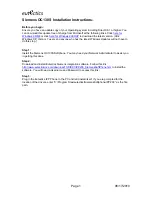
These daughter cards provide the following two functions:
•
Interface to the backplane segments
To be able to communicate with devices attached to any of the backplane
segments, DMM requires an interface to that segment. The interface to the
Ethernet segments on the backplane is provided to DMM via E-MAC,
whereas T-MAC allows DMM to interface with the token-ring segments on
the ShuntBus. Note that DMM requires one MAC daughter card for each
network on the backplane thru which DMM is going to communicate with the
other devices.
DMM will use the interface to the backplane segments to communicate with
the devices attached to these segments using IP. For example, to be able to
manage the 8260 via an SNMP manager, DMM must have an interface to a
network thru which the SNMP manager can be accessed.
•
Network monitoring
Daughter cards attach to the appropriate backplane segment (token-ring or
Ethernet) and listen to the traffic flow and pass all the information back to
DMM.
Note:
Ethernet MAC daughter cards can be installed on EC-DMM or Ethernet
media modules, whereas token-ring MAC daughter cards must always be
installed on token-ring media modules.
The combination of DMM and daughter cards provides a cost efficient
management architecture that consolidates media management into a single
card, while distributing network monitoring across a series of protocol dependent
daughter cards. The DMM is a generic (protocol independent) module that can
be used for both in-band and out-of-band management. As mentioned above,
when used for in-band management, DMM requires a daughter card. The
flexibility and reduction in cost is achieved by distributing the network monitoring
function to daughter cards which can be mounted on EC-DMM (E-MAC only) or
media modules, so they do not use any valuable payload slots. This also means
you only need one DMM to manage the entire 8260. If your network grows and
you need to invest in more network monitoring function, you can install
additional daughter card(s) matching the protocol of your new network(s) by just
mounting them on the existing media module or EC-DMM (E-MAC only).
The MAC daughter cards will be assigned to the token-ring or Ethernet
backplane using DMM commands. Once assigned to a backplane segment, they
will be able to monitor the traffic on that segment and pass the collected
information to the DMM. Note that the MAC daughter cards installed on the
media modules will communicate with the DMM (or EC-DMM) using the MLAN,
as shown in Figure 14 on page 37. The E-MACs installed on the EC-DMM,
however, will use the onboard circuitry of the EC-DMM to communicate with
DMM.
36
8260 Multiprotocol Intelligent Switching Hub
Summary of Contents for Nways 8260
Page 2: ......
Page 6: ...iv 8260 Multiprotocol Intelligent Switching Hub ...
Page 16: ...xiv 8260 Multiprotocol Intelligent Switching Hub ...
Page 22: ...xx 8260 Multiprotocol Intelligent Switching Hub ...
Page 34: ...12 8260 Multiprotocol Intelligent Switching Hub ...
Page 50: ...28 8260 Multiprotocol Intelligent Switching Hub ...
Page 56: ...34 8260 Multiprotocol Intelligent Switching Hub ...
Page 94: ...72 8260 Multiprotocol Intelligent Switching Hub ...
Page 112: ...90 8260 Multiprotocol Intelligent Switching Hub ...
Page 118: ...96 8260 Multiprotocol Intelligent Switching Hub ...
Page 194: ...172 8260 Multiprotocol Intelligent Switching Hub ...
Page 212: ...190 8260 Multiprotocol Intelligent Switching Hub ...
Page 336: ...314 8260 Multiprotocol Intelligent Switching Hub ...
Page 340: ...318 8260 Multiprotocol Intelligent Switching Hub ...
Page 350: ......
Page 353: ......
















































